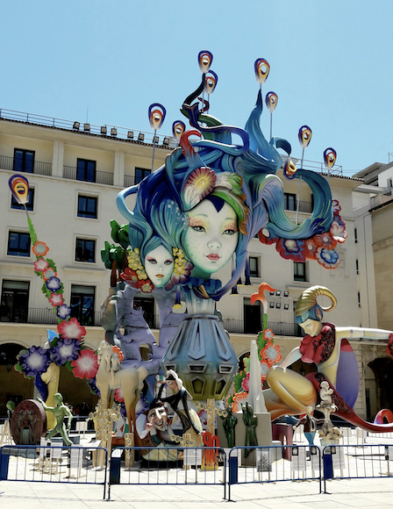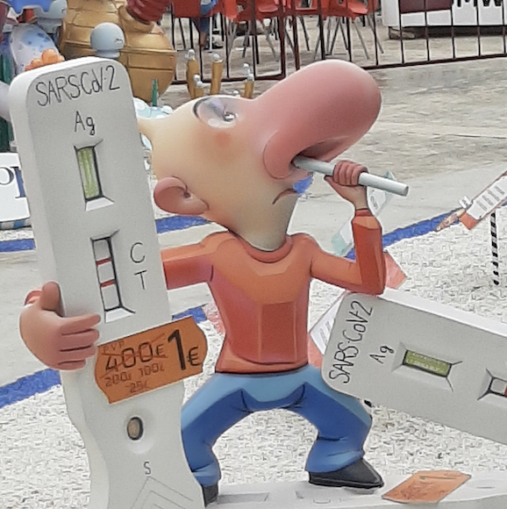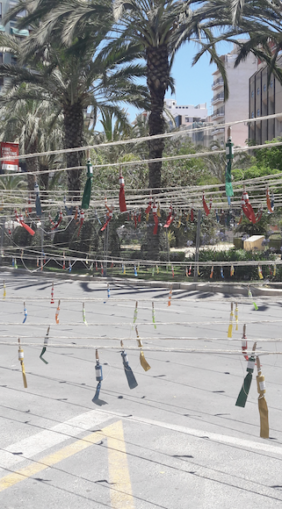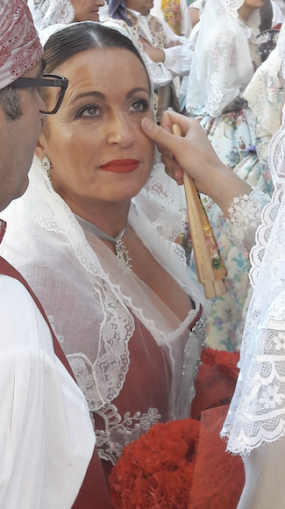The history of burning offerings before the summer solstice can be traced back to prehistoric times. It is part cleansing and part preparation for the coming harvest. At some time in recent history it became entwined with Christianity and now coincides with the feast day of John the Baptist. All across Spain there are overnight parties where bonfires are lit and ritual fire jumping is carried out to symbolically prepare for a new life. There are however two Spanish cities that take the celebrations to a whole new level. The first & oldest of these is Valencia but it has also been joined by Alicante; as together they become the fogueres capitals of the world.
The literal translation of fogueres is bonfire from the Spanish word fuego, which means fire. The fogueres of Alicante is at the end of June, although the preparations begin in September of the previous year. The festival is dedicated to fire & begins with a “pregon” (proclamation) before moving on to the “planta” (setting up the effigies) and the cabalgata del ninot (the parade of the effigies).
The grand finale on the feast day of John the Baptist is when all the effigies are burned in an act of cleansing.
Today the effigies are not so much “whicker man” but unashamedly satirical, often taking aim at politicians, actors, sportsmen and situations like covid lockdowns.
They also take aim at Germans reserving sun loungers and fat Brits with four spare tyres, but as cupid stunt would say, “All done in the best possible taste.”
There is also a lot of competition between the different neighbourhoods or barrios to win the coveted best of fogueres award and the preparation of wooden and paper-mâché figures takes many hours of hard labour to achieve. It is more than anything a community project and involves children to keep the tradition going for future generations.
Some of the sculptures can be four storeys high, with a special place reserved for the grand display in the Plaça de L’Ajuntament, paid for by the ayuntamiento (council)

© Año Nuevo 2018, Going Postal
Fogueres is ranked as one of the most important festivals in the Alicante region and is, alongside easter and the moros y Cristianos, a huge money spinner attracting visitors from all over Spain. It also embraces a number of other presentations which may be unfamiliar but are nonetheless representative of Spain in all its glory.
Covid restrictions by an overzealous health minister for the Valencian community meant fogueres was cancelled in 2019, 2020 and 2021. This however did not dampen the satirical ardour of the effigy makers who were by and large anti-lockdown and busting a gut to have their say.

© Año Nuevo 2022, Going Postal
The above figure will be very familiar to anyone who knows anything about politicians getting rich from PPE and testing kits, by handing out contracts to their mates. As prevalent in Spain as it was in England and heaven sent for the satirists of the fogueres.
One of the main features of the celebration of fogueres is the mascletà, a pyrotechnic event made up by the use of firecrackers to form a noisy and rhythmic composition. In Alicante it takes place at the Plaza Luceros in daylight hours. If done properly the result is like listening to a drum solo, where the size of the firecracker & the distance between charges make a rhythm which is both strangely hypnotic and almost ethereal in its delivery.

© Año Nuevo 2018, Going Postal
Before the fuses are lit the crowds stand thirty deep and spill over into the Avenida Alfonso El Sabio. There are cheers and when the show begins a lingering aroma of cordite & the pop-pop-pop of incendiaries as the charges build up the tempo of the mascletà.
Another endearing tradition of fogueres is the desfile de flores or the “flower parade” where men, women and children put on traditional costume & take their floral tributes through the streets to the Cocatredal De Sant Nicolau De Bari in the centre of what is the old town.

© Año Nuevo 2022, Going Postal
In contrast to many of the other events the flower parade has its roots in Christianity and the offerings are to John the Baptist and not the pagan gods of fire. It is a joyous occasion with bands and pomp where ladies dress in embroidery and lace……….and children learn to behave.
Throughout the city there are bars and restaurants set up on the street. The bars generally open from 5pm until 2am, but anyone familiar with Spain will know all times are subject to change. The ones in the centre also offer music which is a weird blend of techno, rap and Latin.

© Año Nuevo 2018, Going Postal
It is in a bar such as this that a señorita bonita (pretty young woman) taught me a valuable lesson about drinking through the night in temperatures over 30 degrees. One beer, one water and one pee is apparently all you need.
In short, fogueres is part tradition, part ritual and part eating, drinking and laughing until dawn. The effigies, the mascletà and the flower parades are free, as is the grand burning of everything at the end.
It is a somewhat alien concept to spend so long making something only to watch it go up in flames, but who am I to reason why. The only thing I will tell you is that if you go to the burning of the grand display prepare to get wet, no delete that, prepare to get absolutely drenched.

© Año Nuevo 2018, Going Postal
© AÑO NUEVO 2022



